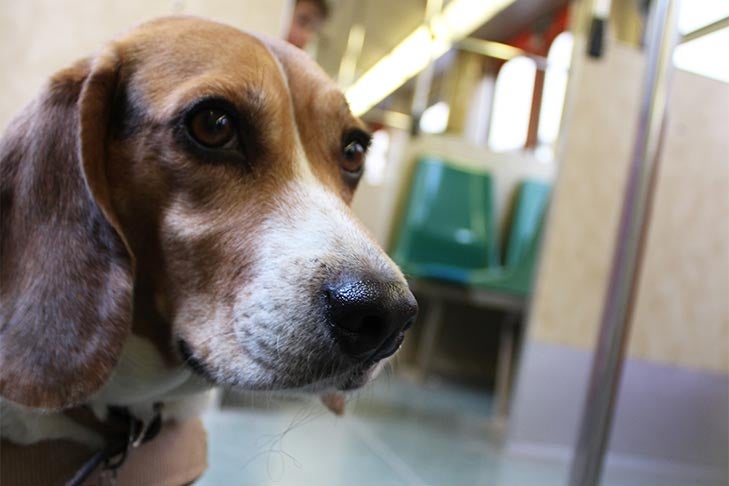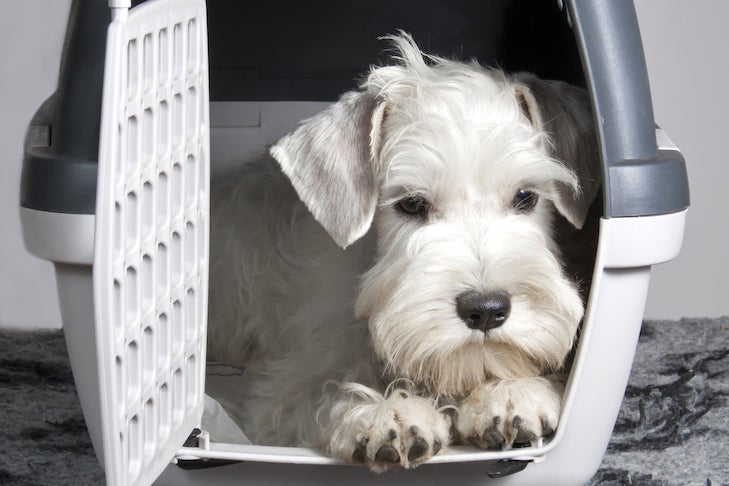
AKC is a participant in affiliate advertising programs designed to provide a means for sites to earn advertising fees by advertising and linking to akc.org. If you purchase a product through this article, we may receive a portion of the sale.
City dwellers and visitors to major cities often find public transportation to be a convenient alternative to driving a car. But what happens when you want your dog by your side? Is your pet included part of the “public” in the public transportation guidelines? Since the rules vary for every location, dog owners should always research their options before taking their dog on public transportation.
Guidance for Service Dogs
The one overall rule is that, no matter where you go, service dogs are allowed to accompany their owners on subways, buses, and trains. Under the Americans With Disabilities Act (ADA), a service animal is individually trained to do work or perform tasks for people with disabilities and must be under the control of the handler.
Emotional support, therapy, comfort, or companion animals are not the same as service animals. Therefore, public transportation systems and the ADA aren’t required to allow them to travel with you. However, many state and local governments do have laws pertaining to emotional support animals in public places.


Public Transit Rules for Pet Dog Passengers
In the guidelines mentioned here, service animals are the only exceptions. Emotional support animals (ESAs) are generally included in the rules for pets. Please check the public transportation systems of each location if you have questions.
New York City
Have you ever tried to drive a car in New York City and find a convenient parking space? If so, you’ll understand why daily ridership reaches 3.2 million on the subway and 1.4 million on buses. The New York Metropolitan Transportation Authority (MTA) allows dogs to ride along with their humans if they can fit in a bag or container and “are carried in a way that doesn’t annoy other riders.”
Service animals aren’t required to be carried in bags or containers. The MTA offers a voluntary service dog identification program. After submitting required documentation, passengers with service dogs receive an ID card to carry to avoid misunderstandings about whether they have a service or companion animal.
Washington, D.C.
If you want a friend in Washington, President Truman suggested getting a dog. But can the dogs in our nation’s capital ride Metrorail or Metrobus? Yes, if they can be carried in a secure container they can’t escape from.

Chicago
The Chicago Transit Authority allows only small pets to travel on buses and trains if they’re inside of a closed protective carrier designed for travel that fits under a seat or on their human’s lap and can be carried by one person. The guidelines say the animal can’t disturb other riders, so if your dog is going to spend the ride barking, you might have a problem.
San Francisco
Bay Area Rapid Transit (BART) warns that station agents can prevent any animal who they believe poses a threat from entering the station. This includes service animals. All non-service pets, including ESAs, must travel in a secure enclosed carrier made for transporting pets.
San Francisco’s Municipal Railway (MUNI) has a different set of rules. Pet can’t ride during peak hours, and during off-peak hours, only one pet can ride on a vehicle at a time. Dogs must wear a muzzle, along with a leash, and ride on their human’s lap or under the seat. Owners are charged a fare for their dog.

Boston
The Massachusetts Bay Transportation Authority (MBTA), also won’t allow non-service dogs to ride during peak hours. Dogs must be leashed and can’t take up a seat, but they can lie underneath the seats.
Atlanta
The Metropolitan Atlanta Rapid Transit Authority allows pets on trains, streetcars, and buses if carried in a secure, rigid pet carrier with a lock or latch to prevent escape.
Miami
Miami-Dade Metrorail requires pet passengers to ride in a cage, kennel, or other pet carrier, such as a bag or backpack, while inside the bus or train. The carrier must be kept out of the aisles, and can’t block the safe movement of other passengers.
Dallas
Dallas Area Rapid Transit (DART) allows pet dogs to ride with their owners if the dog rides enclosed in a securely latched cage or container.
What About Private Ride Providers?

Many city dwellers use Uber and Lyft to get out and about. If you want to take your dog along, you can choose Uber Pet from the Uber app and pay a slightly higher fee. Uber Pet is limited to one pet per trip unless the driver agrees to take more. If your pet leaves excessive hair or waste, you could be charged a cleaning fee.
With Lyft, it’s up to the driver whether to transport a pet dog. If the driver refuses to take your dog, you can cancel the ride and request another driver.
How to Prepare Your Dog for Public Transit
Laying the groundwork for trips on public transit with your dog will pay off. Imagine the reaction of a stay-at-home dog who’s taken underground, surrounded by a crowd of people and the roar of subways, and rushed through electric doors onto a swaying train. Sounds terrifying. Before you take your buddy for a ride, take these steps:
- Socialize your dog to a variety of people and places. Go to shopping areas and parks and have them lie at your feet and learn to relax.
- Teach basic commands. Understanding down and stay can help keep your dog safe. Waiting at doorways, come, and quiet are also valuable cues.
- Consider comfort. If you plan to use a carrier, get your dog used to it at home and on short car rides.
- Desensitize to noises. Play recordings of subway noises, announcements, car horns, and give your dog treats to introduce positive association with potentially scary noises.
- Attention on you. Train your dog to walk on a short leash and stay by your side, ignoring strangers unless encouraged to say hello. Believe it or not, there are some people who won’t want to meet your dog.
- Protect your dog’s health. Make sure your dog is current on vaccines and carry immunization records with you.
- Check identification. Your dog should be microchipped and wear a collar tag to make them easy to identify if they get lost.
- Pack needed supplies. This includes water and a water bowl, cleaning supplies, a blanket or towel, waste bags, and treats.
- Look for signs of stress. If reassurance from a calm owner and experience on the ride doesn’t relieve stress, your dog may be happier waiting for you at home-sweet-home.


